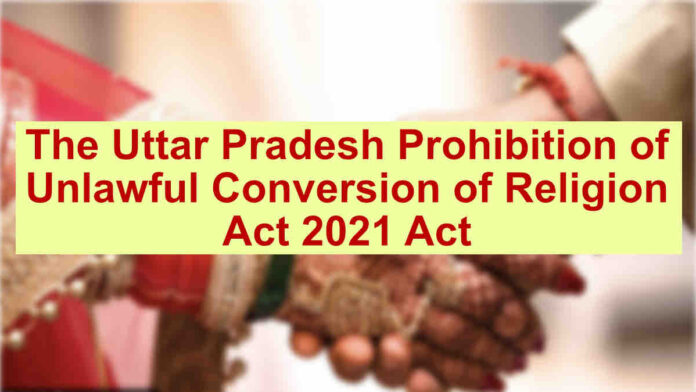The Uttar Pradesh Prohibition of Unlawful Conversion of Religion Ordinance, 2020, which subsequently became The Uttar Pradesh Prohibition of Unlawful Conversion of Religion Act 2021 on approval of the UP State Legislature on 24 February 2021 (in short “The Act” or “The Ordinance”).
Essentially as per the preamble of the Ordinance, it is framed for prohibiting unlawful conversion from one religion to another by misinterpretation, force, undue influence, coercion, allurement or by any fraudulent means or by marriage.
The Ordinance also punishes the perpetrator of said offence, to an imprisonment of 1-5 years in case the accused fails to prove that conversion of woman was not for marriage or by use of force, allurement etc. In case of SC/ST women, The Act imposes a harsher penalty of 2-10 years. This legislation will be reviewed with the angles of its consonance with the Fundamental Rights as enshrined under Part-III of the Constitution of India, 1950.
As stated, The Ordinance makes unlawful conversion of religion by way of marriage between two people punishable with imprisonment as well, which is the main crux of controversy associated with this law, and the pivotal premise upon which it will be reviewed. There are various arguments made against this law that it is in direct conflict with the judgements laid down by Hon’ble Supreme Court and the provisions of the Constitution.
Also, it is pertinent to mention here that The Ordinance came to be promulgated by the Governor under Article 213 of the Constitution and not by usual parliamentary procedure, so the Act’s competence in this regard has also been questioned before the Apex Court.
Hence, this legislation needs to be assessed from the perspective of Fundamental Rights and whether it can stand the test, if viewed on the yardstick of interpretation of these Fundamental Rights by the Hon’ble Supreme Court of India in catena of judgements.
Also Read
The Ordinance:
Upon conjoint reading of Article 367(2) read with Section 30 of General Clauses Act, 1897 an ordinance can be equated as an Act (passed by Legislature) and vice versa. This means that The Ordinance can also be termed as a law and therefore, in the premise of Article 13(2) which provides that the law which is inconsistent with Part III of Constitution be termed as void, The Ordinance is required to be review upon the criterion of Fundamental Rights.
As The Ordinance is law, Governor of a State, is competent to frame laws on the subject matter mentioned in List II and List III of Seventh Schedule to the Constitution. The term ‘marriage and divorce’ falls under Entry 5 of List III of constitution and there is no other entry which empowers legislation to restrict someone who wishes to profess a particular religion by way of conversion. However, The Ordinance can be brought within the ambit of Entry 1 of List II which talks about Public Order which remains its only saving grace on the question of competency. Apart from this, This Ordinance poses several constitutional questions and hence, it has been chosen for the review to assess its true character and Constitutionality.
The essential and important characteristics/contents of The Ordinance shall be briefly stated before moving on to its assessment:
- The Ordinance prohibits conversion of religion by way of (a) misrepresentation, force, undue influence, coercion, allurement or (b) by any fraudulent means or (c) marriage. Furthermore, act of abettor or person who convince or conspire such conversion is also prohibited. The only proviso to this prohibition is reconversion to his/her immediate previous religion by the person who converted his/her religion.(Section 3 of The Ordinance)
- The person(s) competent to lodge First Information Report (“FIR”) under the Ordinance are: (a) aggrieved person (b) his/her parents, brother, sister or (c) any other person related by blood, marriage, or adoption.(Section 4 of The Ordinance)
- Penalty for committing violation of Section 3 as stated above, is described briefly as below (Section 5 of The Ordinance):
| Sr No. | Offence Type | Term of Imprisonment | Fine Amount | |||
| 1. | Conversion of religion(Section 3) | 1-5 Years | Not | Less | than | Rs. |
| 15,000/- | ||||||
| 2. | Conversion of a minor, woman, | 2-10 Years | Not | Less | than | Rs. |
| or person belonging to SC or ST | 25,000/- | |||||
| 3. | Mass Conversion (As defined under Section 2(f) of The Ordinance) | 3-10 Years | Not | Less | than | Rs. |
| of two or more persons) | 50,000/- |
Moreover, it is provided that Courts Shall grant appropriate compensation payable by accused to the victim of said conversion to maximum of Rs. 5,00,000/-
- The Ordinance also makes the marriage of man of one religion to the woman of another religion, if the same had been done with the sole purpose of unlawful conversion, as void marriage.(Section 6 of The Ordinance)
- The offence under The Ordinance are cognizable and non-bailable and Triable by the Court of Sessions.(Section 7 of The Ordinance)
- As per Section 8 and 9, The Ordinance prescribes procedure for legalising the conversion of religion by making a declaration in this regard before and after the conversion. It states that a declaration has to be made before the Ld. District Magistrate (“DM”) 60 days prior to conversion by the individual who wishes to convert his/her religion and the religious convertor who will perform the ceremony of conversion, has to give one month’s notice to DM. Moreover, after the conversion, the converted person is required to file declaration within 60 days to the DM and post that within 21 days he/she is required to appear before DM to establish his/her identity and confirm the contents of declaration. Pertinently, violation of procedures under these provisions will also attract penalty and imprisonment.
- The burden of proof for the purpose of this law shall be upon the person who has caused such conversion and facilitator of such conversion.(Section 12 of The Ordinance)
Also Read
Concerns with The Act and its Analysis:
Since the enactment of this particular legislation there has been huge hue and cry about it. It has been contended primarily that The Ordinance is in apparent violation of Fundamental Rights as enshrined under the Constitution of India. More specifically, there has been a violation of Article 14, 15, 21 and 25 of the Constitution by this enactment. (In this regard several Petitions also came to be filed under Article 32 of the Constitution of India, before the Hon’ble Supreme Court challenging the constitutional validity of The Ordinance.
Pursuantly, the Hon’ble Supreme Court on 03.02.2021, allowed withdrawal of the batch of said Petitions on the ground that Allahabad High Court is already considering this issue. Presently, the issue is pending before Hon’ble Allahabad High Court). Moreover another issue with the Ordinance is its source.
The Ordinance has been promulgated by Governor under Article 213, which provides that this provision could be invoked when:
- State Legislature is not in Session;
- Governor is satisfied that circumstances exists which renders it necessary for him to take action;
Of the aforesaid ingredients, primary issue with The Ordinance is the existence of circumstances which rendered it necessary for Governor to issue such an ordinance. The question now remains is that whether there was a necessity to promulgate The Ordinance in absence of State Legislature?
The simple answer to that question, despite all the controversies and arguments, tis that here is a precedent on this issue wherein Hon’ble Supreme Court has held that Governor himself has to be satisfied of such necessity and he need not give any justification for same.
The Courts also cannot ask him to justify the promulgation of such ordinance (State of Punjab V. Satya Dal Pang [AIR 1969 SC 903]). The Court in this case also held that power of Governor to issue ordinance is as wide as power of State Legislatures to promulgate law.
Violation of Article 14 and 15:
On the face of it, the Act is made applicable to all persons within the State of Uttar Pradesh, irrespective of their religion and it bans conversion from any religion to another. Moreover, as held by Hon’ble Supreme Court, the primary ingredients to assess the legislation upon the touchstone of Article 14 would be to analyse its classification upon intelligible differentia and object sought to be achieved by the legislation. Article 14 does permit classification; however, it prohibits class legislation. Now under this premise, it is important to understand the object which is sought to be achieved by The Ordinance. The Preamble of The Act states that :
“to provide for prohibiting unlawful conversion from one religion to another by misinterpretation, force, undue influence, coercion, allurement or by any fraudulent means or by marriage and for the matters connected therewith or incidental thereto”
From bare perusal it can be said that prohibition of unlawful conversion from one religion to another which is the object of the legislation. Now, as per The Act even if there is conversion of religion by way of marriage, then the same has been held to be punishable by fine and imprisonment. The question arises now is that whether there has been violation of Article 14? And if yes, then how?
Also Read
Firstly, it can be vehemently argued that there is no intelligible differentia to include conversion by marriage in The Act, as the Preamble states that object is to prohibit “unlawful conversion of religion”, the term unlawful conversion as per Section 2(k) of The Act means “conversion not in accordance with the law of the land”. Marriage is not an act which is against the law of any land. Moreover, Section 3 of the Ordinance does not include the word “Unlawful Conversion” and makes any conversion by way of marriage punishable under the Act.
The only proviso here is that converted person be reconverted to his/her previous religion. The Act however does include provision for legalizing the conversion under Section 8 and 9; but that is also required to be asked whether is it necessary to undergo a procedure for marriage between two individuals of different religion whereas the individuals of same religion are not required to undergo any such procedure?
Well, there is Special Marriage Act, 1954 which provides for a similar procedure and provisions in case of marriage between two adults from different religions; however, the provisions of said law are challenged before Hon’ble Supreme Court and it is still pending whereas recently on 13.01.2021, Hon’ble High Court of Allahabad had held that Section 6 and 7 of Special Marriage Act, 1954 requiring publication of 30 days’ notice of intended marriage and inviting objections to the same are directory in nature and not mandatory (Smt. Safiya Pandey & Anr vs State of U.P. Thru. Secy. Home, Lko. & Ors. (HABEAS CORPUS No. – 16907 of 2020).
Moreover, another important decision which though, of only persuasive value to the Indian Courts is required to be considered in order to review Act on touchstone of Article 14, which is the United States Supreme Court’s verdict in the land mark case of Loving v. Virginia (388 U.S. 1 (1967)) wherein it came to be held that laws which ban inter-racial marriage are in direct violation of Equal Protection and Due Process of Law which are enshrined under 14th Amendment to the United States Constitution.
While passing judgement Supreme Court of US observed that Right to marry carries with it, individual’s choice of marital partner. Now in consideration and discussion of aforesaid, it can be concluded that
The Ordinance does not pass the test of Article 14 as simply the purpose of legislation does not match or is achieved by including conversion by marriage independently in the preamble and Section 3 of The Act. Hence, in the humble opinion, to this limited extent, the Act fails the Constitutional Test for equality.
Also Read
Violation of Article 21:
Scope of Article 21 of the Constitution has been constantly expanding since its inception by virtue of innumerable judgements of Hon’ble Supreme Court of India. Recently in the case of K.S. Puttaswamy V. Union of India (2017 (10) SCC 1), Hon’ble Apex Court held as under:
“298. The destruction by the state of a sanctified personal space whether of the body or of the mind is violative of the guarantee against arbitrary state action. Privacy of the body entitles an individual to the integrity of the physical aspects of personhood. The intersection between one’s mental integrity and privacy entitles the individual to freedom of thought, the freedom to believe in what is right, and the freedom of self-determination. When these guarantees intersect with gender, they create a private space which protects all those elements which are crucial to gender identity. The family, marriage, procreation and sexual orientation are all integral to the dignity of the individual. Above all, the privacy of the individual recognises an inviolable right to determine how freedom shall be exercised.”
(emphasis applied)
This is a landmark case wherein the Hon’ble Supreme Court held that the right to privacy is a facet of Article 21 of the Constitution. This means that the law cannot infringe the right to privacy of individuals. In order to determine the same, the Court developed a test called ‘Triple Test’ to check the constitutionality of legislation upon the yardstick of the right to privacy. This test contained:
- Law must have sanctioned the action
- Action is necessary in a democratic society for legitimate aim
- Extent for interference must be proportionate to need for such interference
If the present legislation is looked closely upon the Triple Test, it can be seen that The Ordinance is vulnerable to be in violation of the right to privacy on the aspect of the conversion of religion by marriage and its penalisation. The Law has been brought in by Governor under Article 213 of the Constitution citing the existence of necessary circumstances to take immediate action.
As it has been made under the relevant provision of the Constitution it cannot be termed as illegal, thus in my opinion first test is cleared by The Act. The second test propose requirement of legislation in a democratic society for a legitimate aim. The Ordinance in my opinion does not survive this test as it is made for a purpose of unlawful conversion of religion, for which inclusion of marriage is not required.
Already, The Ordinance included terms like “misinterpretation, force, undue influence, coercion, allurement or by any fraudulent means” which would have been sufficient because with or without marriage, if any of the aforesaid ingredients would have been found, then the said action is already criminalized to achieve the object of the Act.
On the similar premise The Act also fails upon the third test as there is no need for inclusion of conversion by marriage and same is not proportional to the interference made by the State. From the aforesaid, it can be said that The Ordinance does come in way of Fundamental Right to Privacy, recently brought within the scope of Article 21 by the Hon’ble Supreme Court of India as one hand Hon’ble Court proposed right to marriage and conversion to be under Article 21 and on other hand The Ordinance criminalizes the same.
Also Read
Violation of Article 25:
Article 25 of the Constitution provides for freedom of conscience and free profession, practice and propagation of religion. The interpretation of this constitutional provision has undergone huge changes and of those most germane to present review purpose is the verdict of Hon’ble Supreme Court in the case of Rev Stanislaus V. State of Madhya Pradesh (1977 SCR (2) 611) wherein it held that right to practice and propagate religion does not include right to convert and therefore similar provisions as that of The Ordinance were held constitutionally valid by Hon’ble Apex Court under the pretext of Article 25.
However, in the said judgement Hon’ble Supreme Court observed High Court’s observation and held that conversion by way of force, fraud or allurement is banned, meaning otherwise that conversion by free will is not interfered with by the legislations. In the present scenario inclusion of conversion by mere marriage as an independent scope to penalise the accused(s), would bear different consequences.
There is a difference between conversion and forceful conversion which has not been demarcated properly in the Ordinance. Hence, even on this premise, The Ordinance does not survive the test of Article 25 of the Constitution.
Other Problems with The Act:
The Act is Vague:
As stated above, the entire point of controversy in The Act is in relation to penalising conversion of religion by marriage and terming it as a void if found that sole purpose of marriage was religious conversion. The Act does not provide for instances wherein two consenting individuals if enter into pious relationship of marriage then the provisions of said Act do not apply upon them. Indirectly Section 8 and 9 state the procedure to legalise conversion; however, same is extremely tedious and time-consuming.
The apparent question that required to be answered by legislation was whether in case of two consenting individuals who wanted to marry each other, regardless of their religion, was there a need to bring in such provision? This ought to have answered rather than bringing in entire marriage as a whole under the act. Moreover, no prescribed rules are framed which enlists the grounds on which DM shall undertake enquiry under Section 8 and 9. It seems unriddled power has been conferred upon DM and his wisdom has been appreciated to the fullest by the legislation in deciding whether the declaration for conversion is genuine or not.
This kind of vague provision may incite unlawful practices like corruption wherein DM can easily, under the influence of anyone like politically powerful or even otherwise influential family member of either spouses, nullify marriage under The Ordinance despite the fact that two individuals consensually entered into marriage. All this ought to have taken care by Governor while issuing The Ordinance and it had to be made much more specific.
Also Read
Purpose of The Act is improper:
The act was brought in order to counter the situation of forced conversion by way of marriage. In fact the Chief Minister of Uttar Pradesh cited two decisions of single judges of High Court of Allahabad which held the marriages void on the ground of religious conversion to bring in The Ordinance. However, division bench of Hon’ble Allahabad High Court in the case of Salamat Ansari & Ors. V. State of UP and Ors (Crl. Misc. Writ Petition no. 11367 of 2020). Held that
“5. …Right to live with a person of his/her choice irrespective of religion professed by them, is intrinsic to right to life and personal liberty”
and consequently further held that:
“5. …We fail to understand that if the law permits two persons even of the same sex to live together peacefully then neither any individual nor a family nor even the state can have an objection to the relationship of two major individuals who out of their own free will are living together.”
That in para 15 of this judgement Hon’ble Allahabad High Court held that judgements on the basis of which The Ordinance was promulgated is not a good law. Hence, this itself negates The Ordinance’s purpose as the pretext under which it was brought in as cited by Chief Minister of UP is not a good law. This judgment was delivered on 11.11.2020 which is before the promulgation of
The Ordinance, despite which no clarification regarding the same has been made in The Act. This can be considered as classic case of Judiciary V. The Parliament, wherein on one hand consistent view of Fundamental Right to freedom of choice and religion and privacy has been taken by judiciary and Legislature by bringing The Ordinance has tried to by-pass the same.
Conclusion:
Ultimately, the pending issue before Hon’ble Allahabad High Court currently needs to be looked closely as to what decision is taken; however currently, as far as the legislation is concerned, due to lack of clarity, and no basis for inclusion of conversion by marriage and on account of direct conflicting judgements of Supreme Court and High Court on this issue, the present legislation would not be able to withstand the test of constitutionality and hence, the same may get struck down in this background.
Author:
Dhruvin N. Dossani
The author is an advocate at the High Court of Gujrat. He can be reached at adv.dhruvin@gmail.com for any questions or feedback concerning the write-up. The views expressed herein are personal in nature which do not constitute legal advice as such and is not intended to be understood as a solicitation of work.








